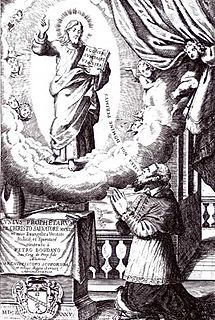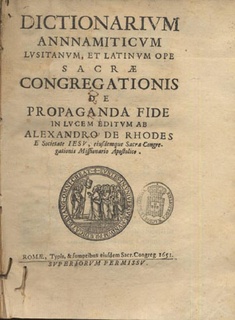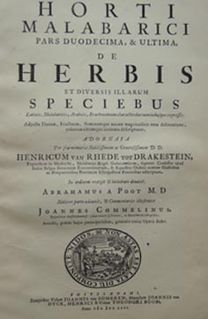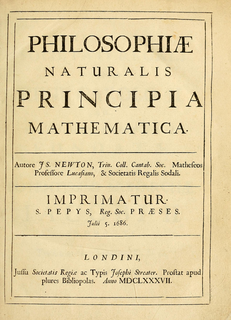 W
WChina Illustrata is the 1667 published book written by the Jesuit Athanasius Kircher (1602–1680) that compiles the 17th century European knowledge on the Chinese Empire and its neighboring countries. The original Latin title was: ”Athanasii Kircheri e Soc. Jesu China monumentis, qua sacris qua profanis, nec non variis Naturae et artis spectaculis, aliarumque rerum memorabilium argumentis illustrata, auspiciis Leopoldi primi, Roman. Imper. Semper augusti Munificentissimi Mecaenatis“.
 W
WCompendium Maleficarum is a witch-hunter's manual written in Latin by Francesco Maria Guazzo, and published in Milan, Italy in 1608.
 W
WCrymogæa in is a book in Latin written by the Icelandic scholar Arngrímur Jónsson and published in Hamburg in 1609 and again in 1610. It was the first historical description of Iceland since Íslendingabók and the first comprehensive book about the history of Iceland.
 W
WCuneus Prophetarum is a philosophical, theological and scientific treatise written by Pjetër Bogdani, an Albanian philosopher, originally published in Padua in 1685 in Albanian and Latin. It is considered to be the most prominent work of early Albanian literature.
 W
WDe Christiana expeditione apud Sinas suscepta ab Societate Jesu ... is a book based on an Italian manuscript written by the most important founding figure of the Jesuit China mission, Matteo Ricci (1552–1610), expanded and translated into Latin by his colleague Nicolas Trigault (1577–1628). The book was first published in 1615 in Augsburg.
 W
WDe Cive is one of Thomas Hobbes's major works. "The book was published originally in Latin from Paris in 1642, followed by two further Latin editions in 1647 from Amsterdam. The English translation of the work made its first appearance four years later under the title 'Philosophicall rudiments concerning government and society'."
 W
WDe Stella Nova in Pede Serpentarii, generally known as De Stella Nova was a book written by Johannes Kepler between 1605 and 1606, when the book was published in Prague.
 W
WTractus de usu flagrorum in re Medica et Veneria is a 1639 treatise by Ioannes Henricus Meibomius (1590–1655). The English title is A Treatise on the Use of Flogging in Medicine and Venery. It was published by the English publisher Edmund Curll.
 W
WThe Dictionarium Annamiticum Lusitanum et Latinum is a trilingual Vietnamese-Portuguese-Latin dictionary written by the French Jesuit lexicographer Alexandre de Rhodes after 12 years in Vietnam. It was published by the Propaganda Fide in Rome in 1651, upon Rhodes's visit to Europe, along with his catechism Phép giảng tám ngày.
 W
WExoticorum libri decem is an illustrated zoological and botanical compendium in Latin, published at Leiden in 1605 by Charles de l'Écluse.
 W
WThe Forerunner of Revenge, also published in Latin and in German as Prodromus Vindictæ, was a pamphlet accusing George Villiers, 1st Duke of Buckingham of having caused the death of King James I of England by poison. It was written by George Eglisham, who had attended upon King James as a physician, and was first published anonymously with a Frankfurt address. It was in fact printed in Brussels by Jan van Meerbeeck. It contributed to the aura of suspicion that led to the Duke of Buckingham's murder, and was reprinted in 1642 to bring Charles I of England into discredit.
 W
WHarmonices Mundi is a book by Johannes Kepler. In the work, written entirely in Latin, Kepler discusses harmony and congruence in geometrical forms and physical phenomena. The final section of the work relates his discovery of the so-called "third law of planetary motion".
 W
WHistoria Naturalis Brasiliae, originally written in Latin, is the first scientific work on the natural history of Brazil, written by Dutch naturalist Willem Piso and containing research done by the German scientist Georg Marcgraf, published in 1648. The work includes observations made by the German naturalist H. Gralitzio, in addition to humanist Johannes de Laet. It was dedicated to Johan Maurits, Count of Nassau, who was the patron of the project during the period of Dutch rule in Brazil.
 W
WHortus Malabaricus is a comprehensive treatise that deals with the properties of the flora of the Western Ghats region principally covering the areas now in the Indian states of Kerala, Karnataka and Goa, written by Hendrik Van Rheede and Itty Achuthan Vaidyar
 W
WLeviathan or The Matter, Forme and Power of a Commonwealth Ecclesiasticall and Civil, commonly referred to as Leviathan, is a book written by Thomas Hobbes (1588–1679) and published in 1651. Its name derives from the biblical Leviathan. The work concerns the structure of society and legitimate government, and is regarded as one of the earliest and most influential examples of social contract theory. Written during the English Civil War (1642–1651), it argues for a social contract and rule by an absolute sovereign. Hobbes wrote that civil war and the brute situation of a state of nature could be avoided only by strong, undivided government.
 W
WThe Lexicon Universale of 1698 is an early modern humanist encyclopedia in Latin by Johann Jacob Hofmann of Basel (1635-1706). It appeared in four volumes with 1,000 pages each.Lexicon Universale, Historiam Sacram Et Profanam Omnis aevi, omniumque Gentium; Chronologiam Ad Haec Usque Tempora; Geographiam Et Veteris Et Novi Orbis; Principum Per Omnes Terras Familiarum [...] Genealogiam; Tum Mythologiam, Ritus, Caerimonias, Omnemque Veterum Antiquitatem [...]; Virorum [...] Celebrium Enarrationem [...]; Praeterea Animalium, Plantarum, Metallorum, Lapidum, Gemmarum, Nomina, Naturas, Vires Explanans. - Editio Absolutissima [...] Auctior [...]. - Leiden: Jacob. Hackius, Cornel. Boutesteyn, Petr. Vander Aa, & Jord. Luchtmans, 1698.
 W
WLoimologia, or, an historical Account of the Plague in London in 1665, With precautionary Directions against the like Contagion is a treatise by Dr. Nathaniel Hodges (1629–1688), originally published in London in Latin in 1672; an English translation was later published in London in 1720. The treatise provides a first-hand account of the Great Plague of London; it has been described as the best medical record of the epidemic. While most physicians fled the city, including the renowned Thomas Sydenham, and Sir Edward Alston, president of the Royal College of Physicians, Hodges was one of the few physicians who remained in the city during 1665, to record observations and test the effectiveness of treatments against the plague. The book also contains statistics on the victims in each parish.
 W
WNotes on the Jewish Temple is a manuscript by Isaac Newton, written in Latin, Hebrew, Aramaic and Greek, which holds notes on the Jewish Temple and its rituals.
 W
WPhilosophiæ Naturalis Principia Mathematica, often referred to as simply the Principia, is a work in three books by Isaac Newton, in Latin, first published 5 July 1687. After annotating and correcting his personal copy of the first edition, Newton published two further editions, in 1713 and 1726. The Principia states Newton's laws of motion, forming the foundation of classical mechanics; Newton's law of universal gravitation; and a derivation of Kepler's laws of planetary motion.
 W
WPrinciples of Philosophy is a book by René Descartes. In essence, it is a synthesis of the Discourse on Method and Meditations on First Philosophy. It was written in Latin, published in 1644 and dedicated to Elisabeth of Bohemia, with whom Descartes had a long-standing friendship. A French version followed in 1647.
 W
WThe Rudolphine Tables consist of a star catalogue and planetary tables published by Johannes Kepler in 1627, using observational data collected by Tycho Brahe (1546–1601). The tables are named in memory of Rudolf II, Holy Roman Emperor, in whose employ Brahe and Kepler had begun work on the tables. The main purpose of the Rudolphine tables was to allow the computation of the positions of the then known planets of the Solar System, and they were considerably more precise than earlier such tables.
 W
WSidereus Nuncius is a short astronomical treatise published in New Latin by Galileo Galilei on March 13, 1610. It was the first published scientific work based on observations made through a telescope, and it contains the results of Galileo's early observations of the imperfect and mountainous Moon, the hundreds of stars that were unable to be seen in either the Milky Way or certain constellations with the naked eye, and the Medicean Stars that appeared to be circling Jupiter.
 W
WSomnium is a novel written in 1608, in Latin, by Johannes Kepler. The narrative would not be published until 1634 by Kepler's son, Ludwig Kepler. In the narrative, an Icelandic boy and his witch mother learn of an island named Levania from a daemon. Somnium presents a detailed imaginative description of how the Earth might look when viewed from the Moon, and is considered the first serious scientific treatise on lunar astronomy. Carl Sagan and Isaac Asimov have referred to it as one of the first works of science fiction.
 W
WTheophrastus redivivus is an anonymous Latin-language book published on an unknown date sometime between 1600 and 1700. The book has been described as "a compendium of old arguments against religion and belief in God" and "an anthology of free thought."